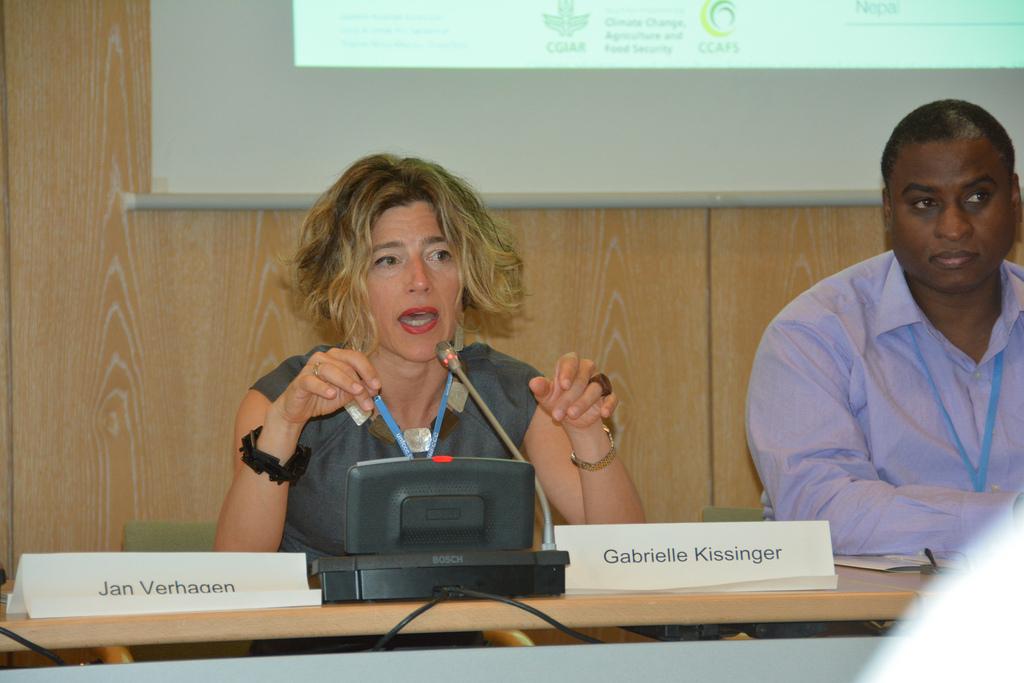Mainstreaming agriculture into national adaptation plans

How does agriculture fit into national climate adaptation plans? Focusing more on integrated and cross-sectoral planning was one of the many perspectives put forward at the CIAT-CCAFS side event during the UNFCCC SB40 in Bonn, Germany.
There is a growing demand and pressure on agriculture. The global population is expected to cross the 8 billion mark by 2030 and to reach 9 billion people by the year 2050, with a growing number of people increasingly consuming meat. To feed this expected population, according to some research reports, global agricultural production will need to increase by 60% by 2050.
This is to be seen in the light of the many known challenges faced by agricultural production in many countries, especially the developing ones. Aside from these known issues are the emerging challenges, which will greatly impact agricultural productivity, chief among which is climate change.
In recognition of climate change expected impact on food production and to help mainstream climate adaptation in the coming decades, the United Nations Framework Convention on Climate Change (UNFCCC) in 2010 introduced the National Adaptation Plan (NAP) mechanism at COP16 in Cancun, Mexico.
The NAP, a measure conceived to encourage countries to start integrating climate adaptation into their development agendas including in agricultural policy planning, was designed to tackle urgent food security issues, livelihood and other development issues in order to reduce countries' vulnerabilities to climate change. Since its conception, a number of countries have been trying to integrate this approach into their existing domestic climate policies or to create new ones based on its central principles.
At a side event hosted by the International Centre for Tropical Agriculture (CIAT) and the CGIAR Research Program on Climate Change, Agriculture and Food Security (CCAFS), on 7 June during the 40th Session of the UNFCCC Subsidiary Body for Scientific and Technological Advice (SB40/SBSTA40) in Bonn, Germany, speakers across a range of perspectives shared their insights and experience on NAPs.
Still many areas of concern
Gabrielle Kissinger, Principal of Lexeme Consulting, presented a new CCAFS Policy Brief, based on an assessment across twelve CCAFS priority countries and a workshop with ten countries (and 37 policymakers). She remarked that a lot of countries lack adequate capacity for planning and implementation of an effective NAP process.

gabrielle kissinger, Lexeme consulting, underlined the need for a cross-sectoral approach in national adaptation planning. Photo: v.atakos (ccafs).
Countries must strengthen capacity to identify and rank climate risks and prioritize response activities. But even more importantly, in many countries, the risk assessments that feed into adaptation planning are done along sectoral lines, instead of the cross-sectoral approach, which better helps countries understand the trade-offs between sectors over critical resources impacted by climate, such as water, land and energy.
On the financing side, Gabrielle Kissinger noted that there is a huge finance gap currently between mitigation and adaptation climate finance, as mitigation projects tend to have better access to funding. More importantly, aligning and mainstreaming climate adaptation activities into national development or sector plans can help steer existing government budgetary allocations and even private sector co-finance to support activities that reduce the risk of climate impacts and promote resilience.
Finance - a core issue
David Kaluba of the Zambian Ministry of Finance at the event shared his country’s experience in adaptation planning, and affirmed the CCAFS workshop findings that success in adaptation planning is often more dependent on the Finance Ministry and Planning Department commitment to the outcomes, than the ministries responsible for implementation. Further, Finance Ministries must understand the risk and impact of climate change on the economy of the country.
For Zambia, the estimated potential impact of climate change on the economy has been put at $13.8 billion – an impact, which will push many more Zambians below the poverty line and increase vulnerabilities. Still, there are many competing development and immediate needs that have to be met, and the relative importance of climate change in that context is not always front and centre.

David Kaluba from the Zambia ministry of finance accounted for some of the financial impacts of climate change. Photo: V.atakos (ccafs)
David Howlett of the UK Department for International Development (DFID) provided a perspective from a donor agency, noting that to get better access to funding, countries have to look at the economic and financial impacts of climate change when conducting their risk assessment. He noted that showing results of what has been done in the past is crucial to accessing funding.
Dealing with complexity
Apart from inadequate funding and the need for better planning and implementation capacity, there are other issues affecting national adaptation planning. While talking about Peru’s experience, Eduardo Durand – the Director General of Climate Change in Peru’s Ministry of Environment – highlighted the challenge of designing a national adaptation plan for a varied and diversified landscape, particularly that of Peru, which contains almost seventy percent of the identified climates within its borders and around eighty percent of known organisms. As of now, Peru does not have a national adaptation plan but is tackling many climate-related issues on regional and local basis.
According to Jan Verhagen, of the Wageningen University and the Least Developed Country Expert Group, there is need for policymakers to learn from other country experiences in mainstreaming adaptation, plus the need to realize there is no one-cap-fits-all solution to adaptation. Local context and realities should be taken into consideration in design and implementation.
In addition, Pradeep Kurukulasuriya, head of UNDP-GEF Adaptation within UNDP, stressed the efforts his team are providing to countries to better undertake integrated approaches in adaptation planning. He also noted the challenge countries have in making decisions in the face of poor information systems, lack of a counter-factual in assessing climate risks and impacts, and the partnerships needed between research organizations, government, civil society and the private sector in order to achieve needed outcomes.
The way forward
Based on the awareness of this lack of adequate information and decision support tools for better planning and implementation, an important part of CCAFS research is focused on closing this gap; through participatory and user-driven approaches geared towards the development of innovative tools to support science-based adaptation planning and decision making processes. These approaches have been used to support stakeholders both at the local level and at the national level.
See more photos from the side event:
DOWNLOAD THE NEW POLICY BRIEF:
Climate adaptation and agriculture: Solutions to successful national adaptation plans
by G. Kissinger, C. Sova, B. Allassane, IA. Maïga, DT. Benefor, DK. Nutsukpo, AZ. Ky-Zerbo, C. Roth-Liehoun, SM. King’uyu, V. Orindi, E. Rojas, JL. Rivera, JP. Mishra, R. Singh, PK. Joshi, J. Kinyangi, P. Aggarwal, R. Zougmore, LS. Sebastian, D. Martinez, H. Neufeldt, J. Twyman, O. Bonilla-Findji and A. Jarvis
Read more:
Can countries embed climate adaptation in their development plans?
Climate-smart agriculture – from the meeting room to grandma’s farm
Business as usual? Why Landscapes matter to private sector stakeholders
Join the discussion
Follow updates from SBSTA on our blog and via @cgiarclimate on twitter.
Oluwabunmi Ajilore is a visiting researcher at the CIAT and science communicator for CCAFS Theme 1.



